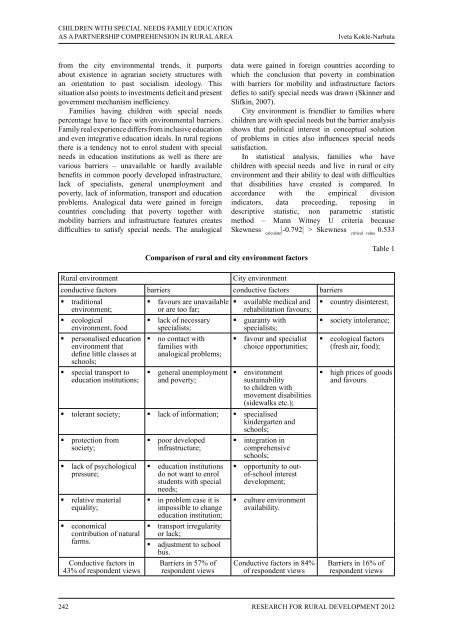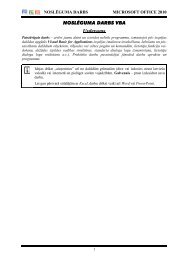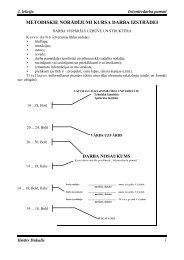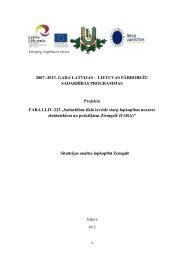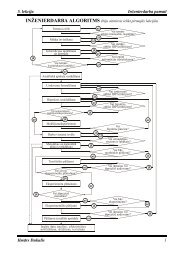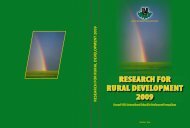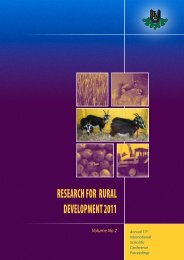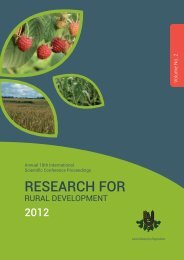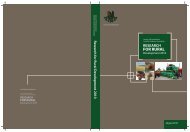LATVIA UNIVERSITY OF AGRICULTURE - Latvijas ...
LATVIA UNIVERSITY OF AGRICULTURE - Latvijas ...
LATVIA UNIVERSITY OF AGRICULTURE - Latvijas ...
- No tags were found...
You also want an ePaper? Increase the reach of your titles
YUMPU automatically turns print PDFs into web optimized ePapers that Google loves.
CHILDREN WITH SPECIAL NEEDS FAMILY EDUCATIONAS A PARTNERSHIP COMPREHENSION IN RURAL AREAIveta Kokle-Narbutafrom the city environmental trends, it purportsabout existence in agrarian society structures withan orientation to past socialism ideology. Thissituation also points to investments deficit and presentgovernment mechanism inefficiency.Families having children with special needspercentage have to face with environmental barriers.Family real experience differs from inclusive educationand even integrative education ideals. In rural regionsthere is a tendency not to enrol student with specialneeds in education institutions as well as there arevarious barriers – unavailable or hardly availablebenefits in common poorly developed infrastructure,lack of specialists, general unemployment andpoverty, lack of information, transport and educationproblems. Analogical data were gained in foreigncountries concluding that poverty together withmobility barriers and infrastructure features createsdifficulties to satisfy special needs. The analogicaldata were gained in foreign countries according towhich the conclusion that poverty in combinationwith barriers for mobility and infrastructure factorsdefies to satify special needs was drawn (Skinner andSlifkin, 2007).City environment is friendlier to families wherechildren are with special needs but the barrier analysisshows that political interest in conceptual solutionof problems in cities also influences special needssatisfaction.In statistical analysis, families who havechildren with special needs and live in rural or cityenvironment and their ability to deal with difficultiesthat disabilities have created is compared. Inaccordance with the empirical divisionindicators, data proceeding, reposing indescriptive statistic, non parametric statisticmethod – Mann Witney U criteria becauseSkewness calculate|-0.792| > Skewness critical value0.533Comparison of rural and city environment factorsTable 1Rural environmentCity environmentconductive factors barriers conductive factors barriers• traditional• favours are unavailable • available medical and • country disinterest;environment;or are too far;rehabilitation favours;• ecologicalenvironment, food• personalised educationenvironment thatdefine little classes atschools;• special transport toeducation institutions;• lack of necessaryspecialists;• no contact withfamilies withanalogical problems;• general unemploymentand poverty;• guaranty withspecialists;• favour and specialistchoice opportunities;• environmentsustainabilityto children withmovement disabilities(sidewalks etc.);• tolerant society; • lack of information; • specialisedkindergarten andschools;• protection fromsociety;• lack of psychologicalpressure;• relative materialequality;• economicalcontribution of naturalfarms.Conductive factors in43% of respondent views• poor developedinfrastructure;• education institutionsdo not want to enrolstudents with specialneeds;• in problem case it isimpossible to changeeducation institution;• transport irregularityor lack;• adjustment to schoolbus.Barriers in 57% ofrespondent views• integration incomprehensiveschools;• opportunity to outof-schoolinterestdevelopment;• culture environmentavailability.Conductive factors in 84%of respondent views• society intolerance;• ecological factors(fresh air, food);• high prices of goodsand favours.Barriers in 16% ofrespondent views242 Research for Rural Development 2012


